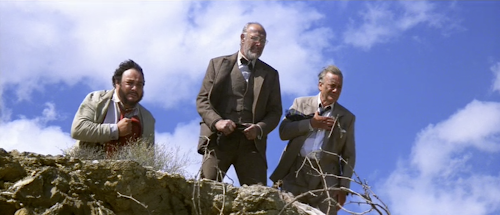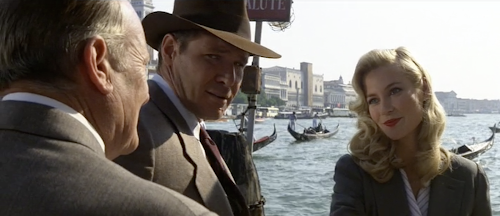 |
| This is what "watching movies back to back" actually means... |
This is the second and final part of the post. After having studied the characters' flaws, in the first part, it is time to see how these flaws get healed, as the story progresses. We will study the father-son subplot, which is the main vehicle for this healing process, and the ways it blends in with the main plot. Plus, we will pin down the film's thematic statement, which is the lesson the characters have learnt, after all this inner process.
PLOT & SUBPLOT
The film's main plot is the story of Indiana Jones going out to find his father, who disappeared while searching for the Holy Grail. Somewhere along the way, some Nazis join in, and Indy has to stop them from obtaining the Grail or "the armies of darkness will march all over the face of the earth," as Henry says -and we take his word for it, in order to follow the story.
The film's main subplot is the parallel story of the relationship between father and son, with all its conflict. This story (which Blake Snyder calls the B-Story) gives the characters the opportunity to deal with their flaws (see first part of this post) and heal the wounds of the past.
 |
| Indy and Henry: the B-Story |
This film has some very inspired moments when plot and B-Story intersect.
First of all, the whole subplot premise of Indy dealing with his dad (at this age) is very satisfactorily justified by the specific main plot: Indy learns that his father has disappeared and goes out to find him. Even though they don't get along well, now, they are forced into a situation where they have to solve their differences and collaborate, in order to save themselves.
The same applies to several of the scenes shared by the two of them. One can trace beats of plot and beats of B-story, within each scene.
Here are some examples:
The zeppelin scene
 |
| Indy: "Do you remember the last time we had a quied drink? I had a milkshake." |
This scene, in the zeppelin, is a typical B-story moment, traditionally known as the "Sex at Sixty" moment: placed around the film's midpoint (60 minutes, more or less), comes a breather from the main action, where the duo can get a little more intimate.
Since the specific subplot is not a romantic one, there is, of course, no sexual intimacy. Indy does attempt emotional bonding with his father, though. This B-story moment doesn't last long, though, since Henry nudges Indy to get back to the main plot: "We have work to do..."
You have zhe diary in your pocket
A team of SS soldiers hold Indy and Henry at gunpoint, demanding Henry's diary. This plot point and its dramatic tension have to do with the main plot and the quest for the Grail.
Subplot complications arise when this tension stirs up the chronic conflict of Indy and Henry's relationship: Henry reprimands his son for not keeping the diary safely hidden away -showing again the same disapproval that has haunted Indy since childhood.
 |
| Henry: "I should have mailed it to the Marx Brothers..." The disapproval that grinds Indy's gears since childhood. |
Scratching the same unresolved issue, Indy gets enraged. His daddy issue proves to be more important than the threat of the SS soldiers (who, by the way, watch the father-son conflict, amazed).
Indy's anger (and zeal to prove himself to his father) resolves the main conflict: he grabs a machine gun and shoots out the SS men.
An excellent example of a plot and subplot intersection!
There is even a punchline; Henry, not believing his eyes, continues preaching to his son, over the dead bodies: "Look what you did!"
 |
| Don't call me "Junior!" |
She's one of them
The SS officer holds Elsa as hostage, demanding the diary. Again, dramatic tension having to do with the main plot.
Then, Henry introduces a twist, advising Indy to ignore the threat, as Elsa, too, is a nazi.
Indy doesn't believe it. He decides to ignore his dad and act on his own impulse.
When Elsa proves Henry right (being a nazi), she tells Indy: "You should have listened to your father," a classic phrase told to a little boy who has messed something up, which hits Indy where it hurts.
A NOTE ON ELSA
Although audiences are used to romantic subplots in action movies, the love story between Indy and Elsa is not the primary subplot (or B-story).
Elsa serves several functions in the story, including the love interest, the shapeshifter, and -most importantly- the catalyst.
 |
| Shadowy Elsa: femme fatale, shapeshifter, and a catalyst. |
She is a catalyst for the plot, helping or betraying Indy, depending on the situation, but she is also a catalyst for the B-story, complicating the father-son conflict: Indy sleeps with her and later finds out that his father has also done the same. Indy's awe towards his father gets even more intense -and awkward.
INNER JOURNEY'S RESOLUTION
The B story concists of a series of scenes, where father and son clash. After several moments of lesser or greater conflict between the two, it seems that they will never get over their issues.
As the movie progresses, though, come three moments where Indy and Henry almost lose each other. Let's see them, one by one:
The tank - At first, Henry almost loses his son, when the tank falls over the cliff. "I've lost him. And I haven't told him anything. Five minutes would have been enough."
 |
| Screenwriting textbook: an "all is lost" moment, just before the break into Act III. Indy's death gives Henry an opportunity for introspection. |
What could he have said in five minutes? How much he loved him? Or some parental advice? Who knows? When Indy climbs back the cliff, reconciliation lasts only a few seconds, before dad orders his son to get back to his feet and to the quest.
Donovan's bullet - Later, Indiana almost loses his father, when Henry gets shot.
 |
| Donovan's bullet gives Indy a serious reason to get the Grail: his father's life. |
YI can almost reach it - Finally, Henry almost loses Indiana, again, when the latter makes a last effort to retrieve the Grail from the crack in the floor.
 |
| Indy's last effort to win his father's approval: he must get him his trophy. |
This last moment is the most critical. It is the moment when Henry chooses his son over the Grail, showing that he has learnt his lesson. He calls his son "Indiana," instead of Junior, asking him to let go of the Grail. He doesn't need this obsession; neither does Indiana need to win his father's approval.
With this, Indiana takes the satisfaction he has been after for decades; he immediately lets go of his efforts to impress his father and becomes an adult, again.
During the aftermath scene, at the very end, Henry summarises the lesson learnt: the Grail had been an obsessive trophy for him, just as it was for Elsa. After this adventure (and after almost losing his son), though, Henry has realised the its true meaning: a symbol of illumination; knowing of what is truly important in life.
Indy, too, has grown. When his father calls him "Junior," again, Indy gets his ultimate lesson: the knowledge that some things -like his father's habits- just don't change. He has still gotten in touch with his father, during this adventure. "Yes, sir!" he smiles, riding with Henry into the sunset.
THEME
Every film's theme is a summary of the lesson learnt (or not learnt) by the characters. Just like the moral of a bedtime story, the theme is what the audience takes home, after the credits, along with the choice to apply it to their own lives or not.
Thus, we can figure out the theme of Indiana Jones and the Last Crusade, by summarising what Henry and Indy have learnt.
Is it a lesson about parent-child relationships? Does it have to do with obsessions versus things that truly matter? Perhaps, people that truly matter? How obsessions stand in the way of our getting in touch with these people?
At the end of the film, Henry speaks about "illumination," as he has learned to put his son before his obsessions. His lesson can be stated as:
"Our obsession for trophies stands in the way of our connecting with now and what truly matters."
His choice acts as a catalyst to Indy's problem, too, who finally sees that his father loves him. Immediately, Indy abandons his struggle to impress him.
Indiana's lesson can be summarised as:
"Our obsession for our parents' approval stands in the way of our growth as adults."
Now, if we consider that Henry's approval was a special Holy Grail to Indiana, we can combine the lessons of both Henry and Indy into the one thematic statement of Henry's lesson, on trophies.
A trophy can be anything: a Grail, a car, a promotion, or the approval of others.
AFTERWORD: A NOTE ON KASIM
Kasim is the character who carries the film's theme.
He tells Indy: "Ask yourself: why do you seek the cup of Christ? Is it for His glory or yours?"
In other words, why are you doing what you are doing? Are you after after your inner truth or simply another trophy?
Unconsciously, Indy gives a true answer: "I didn't come for the cup of Christ. I came to find my father."
It is up to him, however, to make his own message clear to himself: is he after saving his father or after proving that the son is worthy enough to save the father?













